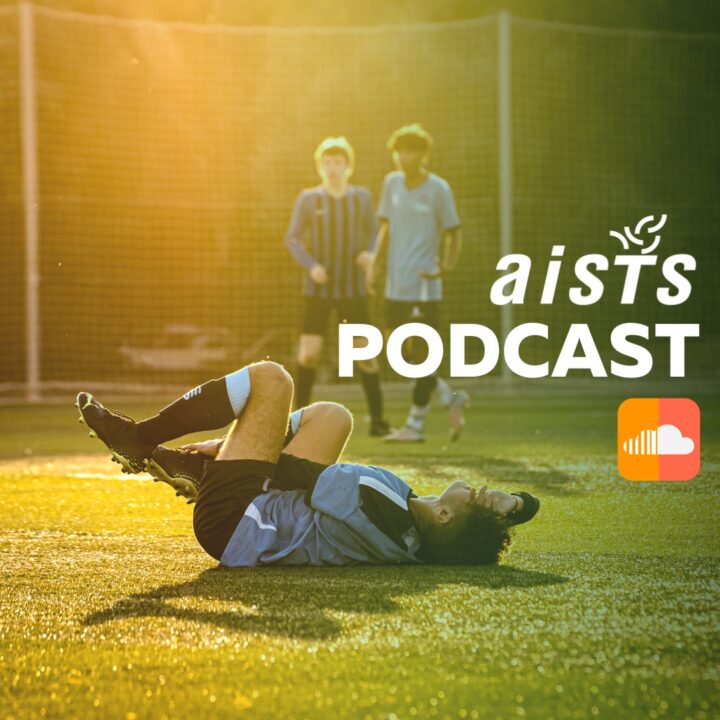
AISTS MEDICINE PODCAST #69
Workload and injuries in professional sports: what is the connection between them?
This AISTS Sport Medicine Podcast discusses the connection between workload and injuries in professional football, particularly with the current fixture congestion in top European leagues as they try to complete the season on a tight schedule due to the COVID-19 pandemic. Inappropriate load management is considered a major risk factor for injuries in football as it increases the risk of acute and overuse injuries. However, exposure to load could allow the body to tolerate load, and training develops physical qualities that could be associated with a reduced risk of injury. The experts suggest that an ideal workload for athletes is a moving target, and it changes constantly based on multiple factors such as the phase of the season, training status, fitness, and fatigue levels. Load should be prescribed or recommended on an individual and flexible basis.
This episode is created together with AISTS Class of 2020 Denys Kulyk, Rijul Sharda, and David Zhang. The AISTS Sport Medicine podcast is supervised by Professor Boris Gojavonic, MD.
AISTS Podcast Transcript
DZ: Hello everyone, it’s the AISTS Sports Medicine podcast, in front of the microphone is me, David Zhang, and my two colleagues Rijul Sharda and Denys Kulyk.
Today our topic is the Workload and injuries in professional football and the connection between them.
It’s a hot topic in light of the current situation with COVID-19, TOP European leagues are getting back after the abrupt stop due to the pandemic and the rest of the season will be played on a tight schedule.
As an example, in Spain, teams will play every third or fourth day for the next 5 weeks. And many ask the question – at such pace, isn’t it dangerous for the health of footballers?
Rijul, Denys, what do you say on this topic?
RS: Actually, the fixture congestion is a well-known problem in football even before the pandemic. FIFPRO, last year released a report named, “At The Limit”, which showcases how competition calendars and travel requirements clash with scientific best practices, leaving some elite players on the limit of their mental and physical capacity.
DK: True, that’s why the role of workload management is so important as it helps reduce the risk of injury and optimize performance by detecting excessive fatigue and identifying its causes.
DZ: Though injury causes in football are multifactorial and involve extrinsic and intrinsic risk factors, wouldn’t you agree that inappropriate load management is a major risk factor for injury?
RS: At professional level, inappropriate loading can increase injury risk by impairing factors such as decision-making ability, coordination, and neuromuscular control. Fatigue from training and competition alters kinetics, kinematics, and neural feedback, reduces joint stability, and thus contributes to increased risk of acute and overuse injuries.
For example, a study by Scott Mclean revealed that in professional football, central fatigue contributes directly to Anterior Cruciate Ligament injuries.
DK: Indeed, 17 of the 28 knee injuries suffered by Premier League players in the 2016-17 season were ACL injuries.
DZ: Thanks for the numbers, Denys. But, gentlemen, on the other hand, what about the protective effect of training?
As I know so far, exposure to load would allow the body to tolerate load, and training develops physical qualities that could be associated with a reduced risk of injury.
DK: Yes, of course, Tim Gabbett called it a ‘Training-Injury Prevention Paradox’ – a phenomenon whereby athletes accustomed to high training loads have fewer injuries than athletes training at lower workloads.
The Model is based on evidence that non-contact injuries are not caused by training per se, but more likely by an inappropriate training programme.
RS: Absolutely, excessive and rapid increases in training loads are responsible for a large proportion of non-contact, soft-tissue injuries. The risk of injury increases when high loads are applied to athletes who are physically or psychologically unfit or when athletes are fit, but are in need of rest.
In both cases, the workload exceeds the athlete’s capacity, leading to excessive fatigue and increased risk of injury.
DK: I want to add also that a number of psychological variables may influence injury risk. These include psychological stressors, such as negative life events, daily hassles and even sports-related stress.
DZ: Ok, how then to determine an ideal workload for athletes?
RS: The “optimal” workload is a moving target.
According to John Orchard, a low training load would undermine a team’s performance and fitness, while an excessive workload would highly increase the risk of injuries and eventually harm team performance.
So, an “optimal” workload would differ for every athlete and it changes constantly based on multiple factors, such as the phase of the season, training status, fitness and fatigue levels, sleep quality, etc.
DK: And analyzing external and internal loads is essential for it.
External loads are external stimulus applied to athletes such as sprints or weight lifted, while internal load is a physiological and psychological response to external loads, such as heart rate and blood lactate concentration etc.
Monitoring external load is key to understanding the work completed, the capabilities and capacity of the athletes.
While the constant monitoring of internal load can help identify recovery needs, anticipate health issues, and also help adjust training and competition programs.
RS: Just to mention, there are also some important workload metrics, like Chronic Load, Acute Load, Freshness Index etc, but it’s a topic for a separate podcast.
DZ: So, to summarize everything that we discussed here, what recommendations could you give for prescribing training and competition load?
DK: Experts suggest that football teams should contemplate squad rotations to protect players from large increases in match loads which may put them at higher risk of injury.
As illustrated by a 14-year prospective study made by professors at Linkoping University, muscle injury rate in professional football is higher in matches played within 5 days since the previous match, compared to one match per week.
RS: Adequate recovery sessions should be incorporated after intensive training periods, competitions and travel. Furthermore, care should be given to nutrition, hydration, sleep, rest, active rest, relaxation strategies and emotional support.
In- and off-season breaks are also important: ideally, medical evidence states that a minimum of four to six weeks of complete rest should be observed in the off-season and two weeks in the mid-season.
DZ: After listening to what you have suggested, I see that there is no “one size fits all” principle. Load should be prescribed or recommended on an individual and flexible basis.
DK: Absolutely!
DZ: Great! Thank you Rijul and Denys for an interesting conversation. Thank you all for listening. Stay tuned!





